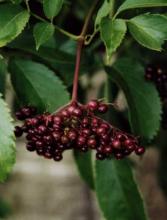
Sambucus canadensis, Sambucus nigra
This small tree is a member of the Caprifoliaceae, the Honeysuckle family. It flowers in the early summer, late June and first few weeks of July, and the berries usually ripen by early September. It thrives in moist locations, requiring very little care if it likes its home. Traditionally home to fairies and nature spirits, it was customary to leave offerings to the Elder to ensure that it would protect the rest of the garden and ensure its fertility. All parts can be used – although I use the flowers and berries primarily, since the leaves and bark are generally just purgative. The root is toxic, as are all parts of the plant if used fresh: must dry the flowers, and blanch the berries for 30 seconds before use.
Elemental associations: Air
Phytochemistry: Flowers: Flavonoids, glycosides, tannin, essential oil. Berries: polysaccharides, ascorbic acid, flavonoids including anthocyanidins (D. Hoffmann)
Actions: Flowers: Diaphoretic, anti-catarrhal. Berries: Immuno-stimulant, diaphoretic, laxative, anti-viral
Specific systems: Respiratory, upper respiratory
Elder has a long history of medicinal and magical use. It is used to fashion wands (as are many trees with hollow stems) and to communicate with beings in the ‘afterlife’. Taken in large doses, it can induce visions as part of a well-structured ceremony.
The flowers are a premier remedy for fevers resulting from respiratory conditions. In addition, they are very effective in thinning out mucus secretions (combine with Catnip for that purpose) and therefore make an excellent cold-and-flu remedy (take as a hot tea).
The berries have a stronger effect on the immune system, due perhaps to their rich content of vitamins and antioxidants. They can also be used as circulatory stimulants, helpful in long-term conditions of recovery, again from respiratory conditions like bronchitis.
The leaves are a bit purgative when taken as a tea, helping (albeit violently) to remove waste and poisons from the digestive tract. For this use they would be employed dry; used fresh, Elder leaves are an excellent poultice for sprains, applied as a compress with Yarrow and/or Arnica.
Indications: Upper and lower respiratory viral infections, congestion in the sinuses and bronchi, immune deficiency
Contraindications: Do not use the fresh plant in any form
Preparation/Dosage: A hot infusion of the dry flowers is the traditional fever remedy; use 3 TBS per quart of water and serve as hot as possible; cover the patient and allow rest. A tincture of the dry flowers can also be prepared, in 25% alcohol, 1:3. Take 1-2 tsp. in hot water.
The berries are best slightly blanched and juiced. This juice can be preserved with 25% alcohol and, if desired, mixed with the tincture. Elderberry jam is also a traditional preparation, less rich in vitamins (due to the high, long heat) and perhaps a bit sugary, but very effective as a food during colds and flu (especially for kids!).
